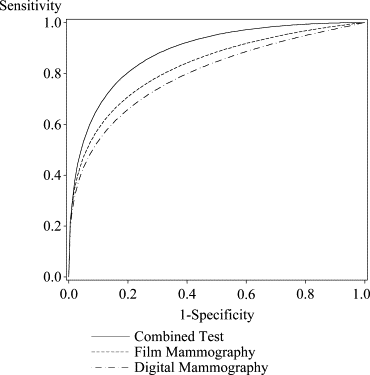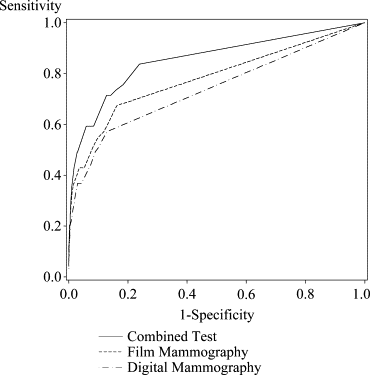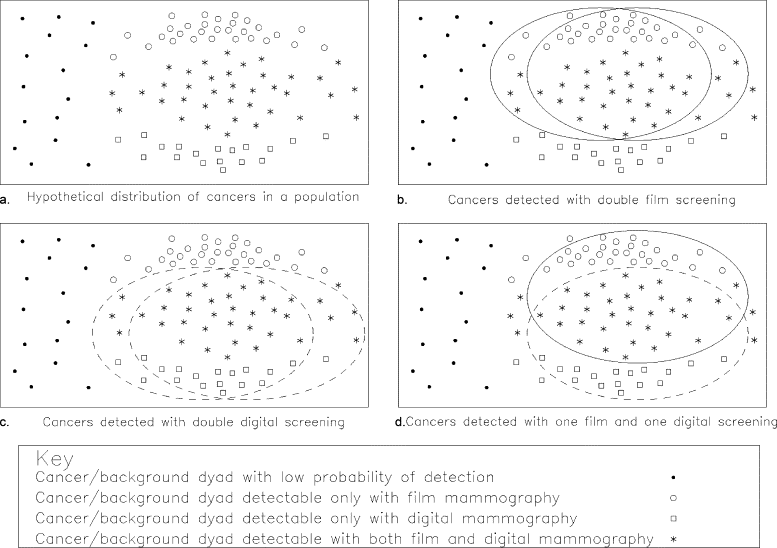Rationale and Objectives
We sought to compare the cancer detection rate and receiver operating characteristic (ROC) area under the curve of full-field digital mammography, screen-film mammography, and a combined technique that allowed diagnosis if a finding was suspicious on film mammography, on digital mammography, or both.
Materials and Methods
We used the data originally analyzed by Lewin and associates in 2002. In that trial, 6,736 paired full-field and digital mammograms were performed in 4,489 women. We used parametric and nonparametric tests to compare the area under the curve for ROC scores of film-screen only, digital mammography only, and the combined test. We used McNemar’s test for paired proportions to compare the cancer detection rates.
Results
With the parametric test, neither the difference in the area under the curve between the film and combined nor the difference between the digital and combined ROC curves was significant at the Bonferroni-corrected 0.025 α level (film versus combined difference = 0.0563, P = .0712; digital versus combined difference = 0.0894, P = .0455). The nonparametric test showed that there was a significant difference between both film and combined (difference = 0.073, P = .008) and digital versus combined ROC curves (difference = 0.1164, P = .0008). The continuity-corrected McNemar’s test showed a significant increase in the proportion of cancers detected by the combined modality over film (χ 2 = 7.111, df = 1, P = .0077), and over digital (χ 2 = 12.071, df = 1, P = .0005).
Conclusion
Using two mammograms, one film and one digital, significantly increases the detection of breast cancer.
Three recent clinical trials with paired designs have compared full-field digital and screen-film mammography ( ). Each woman was imaged with both digital and film machines. The purpose of these trials was to compare the diagnostic accuracy of the digital and film approaches. Interestingly, in each study, more cancers were detected than would have been detected by either modality alone ( Table 1 ). This suggests that full-field digital mammography and screen film mammography could be used in tandem to improve breast cancer detection.
Table 1
Proportions of Cancer Detected by Each Modality in Three Clinical Trials
Trial Screen Film Mammography Full-Field Digital Mammography Combined Modalities Lewin et al. ( ) 32/49 = 65.3% 27/49 = 55.1% 41/49 = 83.7% Skaane et al. ( ) ⁎ 28/31 = 90.3% 23/31 = 74.2% 31/31 = 100% Pisano et al. ( ) 174/335 = 51.9% 185/335 = 55.2% 237/335 = 70.7%
⁎ No interval cancers were reported in this study.
Get Radiology Tree app to read full this article<
Get Radiology Tree app to read full this article<
Get Radiology Tree app to read full this article<
Materials and methods
Get Radiology Tree app to read full this article<
Get Radiology Tree app to read full this article<
Get Radiology Tree app to read full this article<
Get Radiology Tree app to read full this article<
Get Radiology Tree app to read full this article<
Results
Get Radiology Tree app to read full this article<
Table 2
Parametric ROC Analysis Results
Statistics Film Versus Combined Digital Versus Combined Film Versus Digital First modality AUC 0.831 0.7956 0.8283 Standard error 0.0406 0.0267 0.0423 Second modality AUC 0.8873 0.885 0.7865 Standard error 0.0259 0.0509 0.0538 AUC difference 0.0563 0.0894 0.0418 Standard error difference 0.03122 0.04467 0.06357Z -score 1.8045 1.9996 0.6587P value .0712 .0455 .5101
Get Radiology Tree app to read full this article<
Get Radiology Tree app to read full this article<
Table 3
Nonparametric ROC Analysis Results
Statistics Film Versus Combined Digital Versus Combined Film Versus Digital First modality AUC 0.7811 0.7377 0.7811 Standard error 0.037 0.0381 0.037 Second modality AUC 0.8541 0.8541 0.7377 Standard error 0.0315 0.0315 0.0381 AUC difference 0.073 0.1164 0.0434 Standard error difference 0.0275 0.0347 0.0501 χ 2 ( df = 1) 7.0397 11.281 0.7507P value .008 .0008 .3863
Get Radiology Tree app to read full this article<
Get Radiology Tree app to read full this article<
Get Radiology Tree app to read full this article<
Discussion
Get Radiology Tree app to read full this article<
Get Radiology Tree app to read full this article<
Get Radiology Tree app to read full this article<
Get Radiology Tree app to read full this article<
Get Radiology Tree app to read full this article<
Get Radiology Tree app to read full this article<
Get Radiology Tree app to read full this article<
Get Radiology Tree app to read full this article<
Get Radiology Tree app to read full this article<
Get Radiology Tree app to read full this article<
Get Radiology Tree app to read full this article<
Get Radiology Tree app to read full this article<
Get Radiology Tree app to read full this article<
Get Radiology Tree app to read full this article<
Get Radiology Tree app to read full this article<
Get Radiology Tree app to read full this article<
Acknowledgment
Get Radiology Tree app to read full this article<
Get Radiology Tree app to read full this article<
References
1. Lewin J.M., D’Orsi C.J., Hendrick R.E., et. al.: Clinical comparison of full-field digital mammography and screen-film mammography for detection of breast cancer. AJR Am J Roentgenol 2002; 179: pp. 671-677.
2. Skaane P., Young K., Skjennald A.: Population-based mammography screening: comparison of screen-film and full-field digital mammography with soft-copy reading—Oslo I Study. Radiology 2003; 229: pp. 877-884.
3. Pisano E.D., Gatsonis C., Hendrick E., et. al., Digital Mammographic Imaging Screening Trial (DMIST) Investigators Group: Diagnostic performance of digital versus film mammography for breast-cancer screening. N Engl J Med 2005; 353: pp. 1773-1783.
4. Sickles E.A., Weber W.N., Galvin H.B., et. al.: Baseline screening mammography: One vs two views per breast. AJR Am J Roentgenol 1986; 147: pp. 1149-1153.
5. Chakraborty D.P., Winter L.H.: Free-response methodology: Alternate analysis and a new observer-performance experiment. Radiology 1990; 174: pp. 873-881.
6. Hanley J.A., McNeil B.J.: A method of comparing the areas under receiver operating characteristic curves derived from the same cases. Radiology 1983; 148: pp. 839-843.
7. Metz C., Wang P., Kronman H.A.: New approach for testing the significance of differences between ROC curves measured from correlated data.Deconinck F.Information Processing in Medical Imaging.1984.The Hague, the NetherlandsNijihoff:
8. DeLong E.R., DeLong D.M., Clarke-Pearson D.L.: Comparing the areas under two or more correlated receiver operating characteristic curves: A nonparametric approach. Biometrics 1988; 44: pp. 837-845.
9. Hajian-Tilaki K.O., Hanley J.A., Joseph L., et. al.: A comparison of parametric and nonparametric approaches to ROC analysis of quantitative diagnostic tests. Med Decis Making 1997; 17: pp. 94-102.
10. Zhou X.-H., McClish D.K., Obuchowski N.A.: 2002.John Wiley and SonsNew York
11. Daniel W.W.: 2nd ed.1990.Duxbury Thomson LearningPacific Grove, CA
12. Anttinen I., Pamilo M., Soiva M., et. al.: Double reading of mammography screening films—One radiologist or two?. Clin Radiol 1993; 48: pp. 414-421.
13. Thurfjell E.L., Lernevall K.A., Taube A.A.: Benefit of independent double reading in a population-based mammography screening program. Radiology 1994; 191: pp. 241-244.
14. Ciatto S., Rosselli Del Turco M., Burke P., et. al.: Comparison of standard and double reading and computer-aided detection (CAD) of interval cancers at prior negative screening mammograms: blind review. Br J Cancer 2003; 89: pp. 1645-1649.


